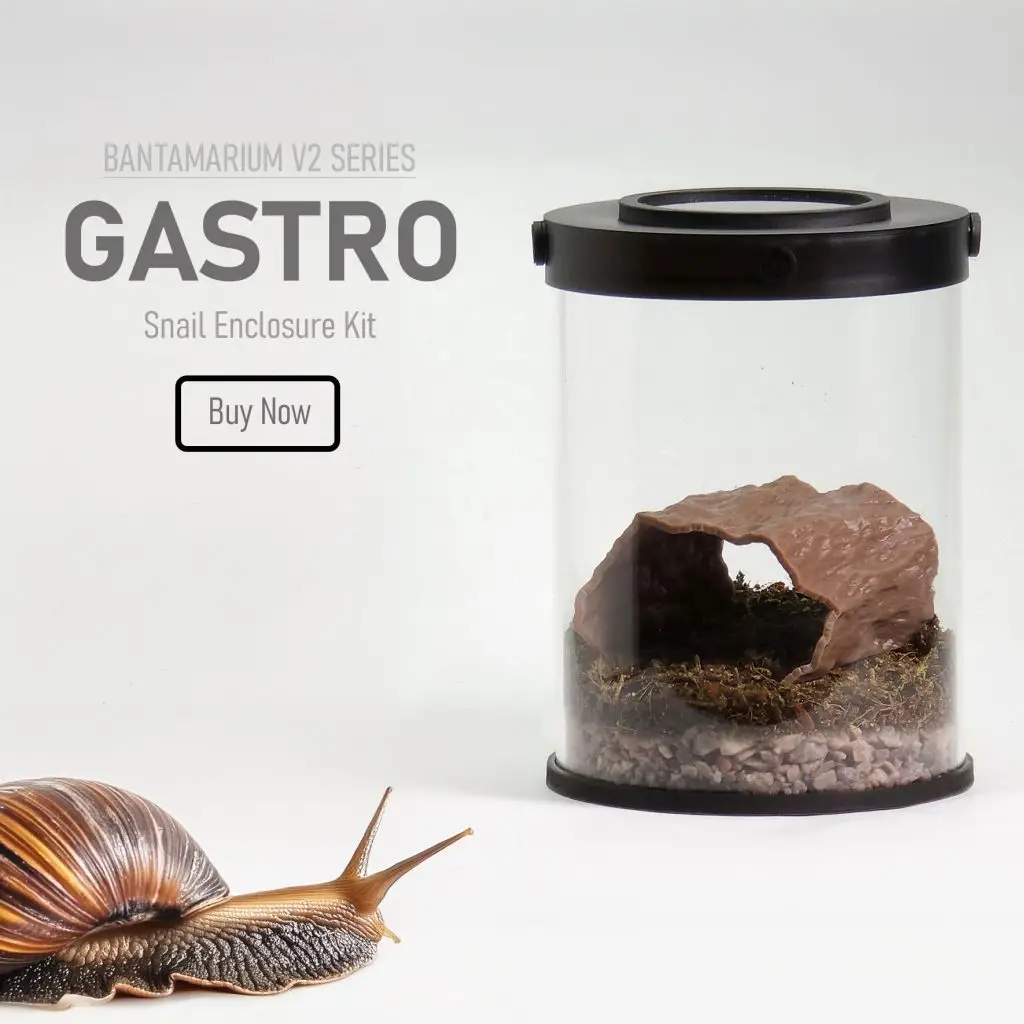The Otala lactea, also referred to as the Milk Snail, is a fascinating creature that belongs to a common family of terrarium snails.
This species of snail is found across the world and has some unique characteristics that make it stand out from the rest.
In this article, we will explore its fascinating history, taxonomy, physical qualities, reproduction, natural habitats, and benefits to our health and wellness.
Read on to find out more about the fascinating Milk Snail!
| Characteristics: | |
|---|---|
| Common Name | Milk Snail, Spanish Snail |
| Family Name | Helicidae |
| Scientific Name | Otala Lactea |
| Use | Cleaning, Aerating Soil, Pets |
| Temperament | Non-aggressive |
| Lifespan | 1-12 Years |
| Diet | Omnivore |
| Adult Size | up to 1.5 in |
| Breeding Type | Egg Layer |
| Care Level | Easy |
| Minimum Tank Size | 10 Gallons |
| pH | 7.0-8.0 |
| Hardness | Soft - Moderate |
| Temperature | 60-75°F |
Table Of Contents:
ToggleWhat Are Milk Snails?
Milk Snails, scientifically known as Otala lactea, are a species of gastropods belonging to the Helicidae family.
They are small yet colorful snails that can grow up to be more than an inch long.
The common name, Milk Snail, comes from their light-colored shells and milky secretion which is sometimes mistaken for milk.
They are mainly found in humid and warm environments, especially in areas with plentiful vegetation.
Create an ideal habitat for your pet snails with our Customizable Snail Enclosure Kits, which include everything you need to get started.
What Do Milk Snails Look Like?
Otala lactea is a small snail species typically measuring around 1.5 inches in length when fully grown.
The shell of the Milk Snail is usually a solid brown color, although more yellowish and white variations can also be found.
It has a unique yellowish or white, tooth-like operculum, often referred to as the “milky secret” due to its whitish hue.
The snail is also equipped with four pairs of tentacles which, when fully extended, measure about 1 cm in length.
The Milk Snail’s body is covered in thousands of microscopic hairs allowing them to move smoothly over rocks, leaves, and other objects in their environment.
At the base of its body, it has a foot-like structure, which is unlike other snails, as it allows them to burrow during the day and retreat when stressed or in need of shelter.
This snail’s anatomy makes it both an efficient crawler and burrower.
Benefits Of Using Milk Snails
Using Milk Snails in vivariums can provide many benefits and enhance the overall environment of the tank.
Not only are they easy to care for and great at eliminating waste, but they also provide a variety of interesting and interactive activities, such as scavenging, grazing, and cleaning up excess food.
Otala lactea are excellent tank cleaners as they help keep the substrate clean, break down excessive organic wastes, and feed on algae and dead plant matter.
Milk Snails also provide interesting visual appeal as they are colorful, active members of the tank.
This will excite and interest tank-dwellers and viewers alike, making the tank that much more vibrant and enjoyable to explore.

Milk Snail Facts
Milk Snails are an ancient species of land snail that have been observed since the dawn of civilization.
Their razor-sharp appetite allows them to feed on native vegetation as well as other decaying debris, and they are also known to be relatively docile which makes them suitable pets.
Habitat
The Milk Snail is a species of land snail that originated in Europe, particularly in the Western and Central Mediterranean regions.
It is also found in North America, particularly in the Southern United States, as well as other areas of the world including some parts of Asia and Africa.
Milk snails usually live within grasslands, meadows, and other places with abundant vegetation.
They generally inhabit swamps, wetlands, and areas with high levels of moisture.
They can also live in forests and gardens, especially on the edges of lawns and flower beds.
They also prefer to inhabit rocky areas, especially since the snails can make use of the numerous crevices and cracks present in the rocks to hide and protect them.
Our Bioactive Land Snail Substrate Blend is specially formulated to meet the needs of various land snail species, providing an optimal balance of moisture and nutrients.
Diet
In their natural habitats, Otala lactea feed on plant matter and decaying organic matter.
They particularly prefer herbivorous plants and fruits, as well as fungi and bacteria growing on rotting wood and leaf litter.
These snails can also be found grazing on lichens, mosses, and other organisms found on rocks, tree barks, and soil.
They may even feed on eggs and immature stages of other snails.
Otala lactea are also known to eat their shells for calcium and other minerals to help them build new shells.
Additionally, it is believed that they consume clay and other soil particles to obtain important minerals necessary for their shell formation.
Due to their size and nocturnality, Milk Snails can be difficult to observe while they feed, but they are known to eat very slowly and continually, feeding on their natural source of food throughout the day and night.
Temperament
Otala lactea is generally calm and non-threatening around humans and other animals.
As ambulatory species, they typically move around quite slowly and rarely pose any danger.
They are solitary creatures, never forming colonies or groups, and are usually found alone.
Although they can move quite quickly and have an excellent sense of touch, they generally aren’t aggressive and remain peaceful unless provoked.
Moreover, they are considered small and harmless enough to be accepted among other terrarium inhabitants such as frogs, lizards, and even fish.
Lifespan
The lifespan of Otala lactea can be quite long, up to twelve years, or even more.
They grow slowly, with their shells taking two to three years to reach full size.
They reproduce sexually, with both male and female Milk Snails required for successful fertilization.
The female lays a cocoon of jelly-containing eggs, which hatch after a few weeks.
The young Milk Snails take a few weeks to reach adulthood, at which point they can begin to reproduce themselves.
Breeding
Milk Snails mate through a very unique mating ritual.
The two snails will use their tentacles to form a sort of loop, symbolizing their mutual bond.
They also produce a mucus-like material that allows them to recognize each other and unite.
Once the ritual is complete, they will hide in the ground and lay their eggs in the late spring or early summer.
Where To Find Milk Snails
Finding Milk Snails in the wild can be a tricky pursuit, as they are rarely seen in large numbers.
They are typically present in any form of moist, damp environment, including woodlands, grasslands, meadows, and gardens.
They are most active and abundant during the spring and summer months, but can sometimes be spotted during the winter in mild climates.
If you are looking for Otala lactea for sale, you may be able to find them in pet stores, particularly those that specialize in reptiles and amphibians.
Such stores may also be able to provide advice and information on captive breeding and keeping these creatures if you are interested in doing so.
Milk Snail Care
To keep Milk Snails happy provide them with a humid, sheltered environment, plenty of food, and clean water.
Ensure that the temperature in the enclosure is warm and consistent.
Additionally, Otala lactea needs a place to hide and burrow and can benefit from occasional calcium supplements.
Tank Requirements
The ideal tank requirements for Milk Snails are quite straightforward.
The best vivarium type is a glass terrarium with a secure lid that allows good air circulation.
Recommended pH levels should be between 6.8 and 7.4. The hardness should be fairly soft between 5 to 8 dGH.
The optimal temperature should be around 24°C – 26°C, but the snails will tolerate temperatures from 14°C to 32°C.
A good terrarium substrate choice would be a mixture of regular potting soil and sand.
Finally, the best terrarium lighting option is to use low-voltage LED lighting that simulates daylight.
What Do Milk Snails Eat?
Feeding Otala lactea is simple and easy, but you need to make sure that you provide them with the right kinds of food.
Here are some tips on feeding your Milk Snails a healthy and balanced diet:
- Provide a healthy mix of plant-based foods such as lettuce, spinach, and other green leafy vegetables.
- Make sure to include some fruits as well, such as apples and pears.
- Include a variety of whole grains and nuts in their diet.
- Commercial snail pellets are also a great supplement for Milk Snails.
- Supplement their diet with a shallow bowl of water for drinking.
Overall, Milk Snails eat a wide variety of food items, from fruits and vegetables to whole grains and nuts.
These snails are not picky eaters, so feel free to try out different combinations until you find the perfect one for Otala lactea.
If you’re more of an avid hobbyist like myself, be sure to check out my ultimate DIY land snail food guide. I give a more in-depth explanation of the best foods and my favorite recipe.
Best Tankmates For Milk Snails
The Milk Snail is a peaceful species that thrives when kept together with compatible tank mates.
Despite its timid nature, this snail does not shy away from the occasional game of tag with the other members of its shared space.
When it comes to selecting compatible tankmates for Milk Snails, the most suitable ones are other species of snails such as Apple Snails, Chinese Whelk Snails, Malaysian Trumpet Snails, and Great Pond Snails.
These tankmates share similar beneficial qualities with the Milk Snail such as promoting the growth of healthy bacteria in the tank, providing food for other tank inhabitants, and helping aerate the soil.
I would also recommend other clean-up crew-type inhabitants like springtails, millipedes, and isopods.
Conclusion
The Otala lactea is a unique and fascinating creature that is beneficial to the environment in many ways.
Not only is it beneficial to its natural environment, its meat is delicious, and the juice has been used in medicine for centuries.
This unique species can also be kept as a pet, and its unique features can provide an interesting addition to any tank.
Whether you want to explore its history, learn about its natural habits, or make it a part of your diet, the pet snail truly deserves its place in the spotlight.
Create the ideal habitat for your snails with our species-specific soil mixes and Insect Enclosure Kits. These products provide everything you need for a successful and thriving snail habitat.
Frequently Asked Questions
Yes, milk snails (Otala lactea) are legal in the US.
No, milk snails (Otala lactea) do not reproduce asexually. They require another snail to mate with in order to produce offspring.
Milk snails (Otala lactea) are found throughout Europe and North Africa, along with Portugal, Spain, Malta, and Jordan.
They have also been introduced to parts of the United States, including California and Texas.
The lifespan of a milk snail (Otala lactea) is approximately 3 to 12 years.
Milk snails primarily feed on plant matter, such as leaves, flowers, fruits, and stems. They are not picky eaters and will consume a wide range of plants, both cultivated and wild.
The frequency of egg-laying depends on various factors such as age, environmental conditions, and availability of food and water.
In general, milk snails can lay several clutches of eggs per year, with each clutch containing 20 to 50 eggs.





